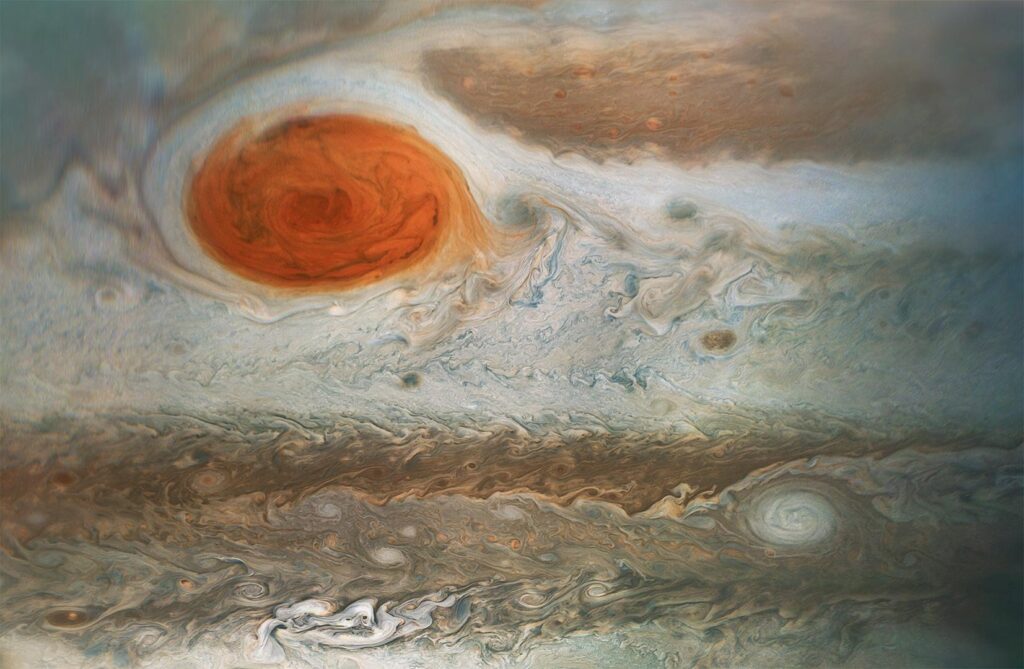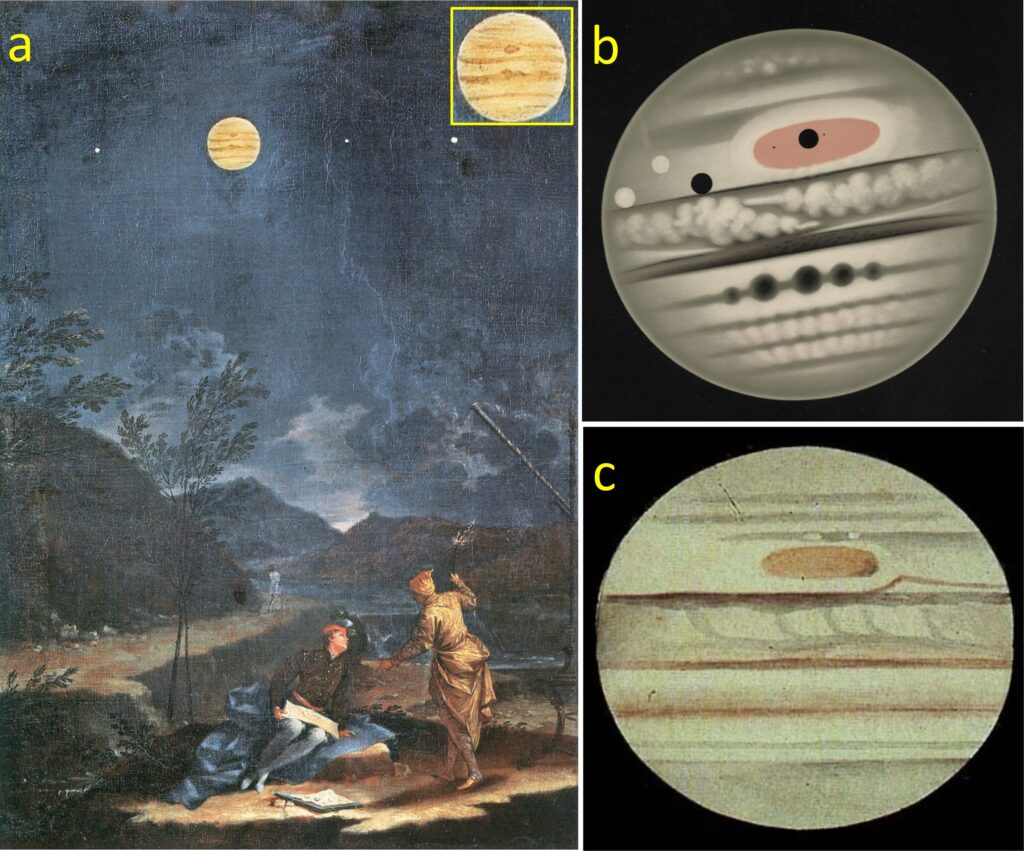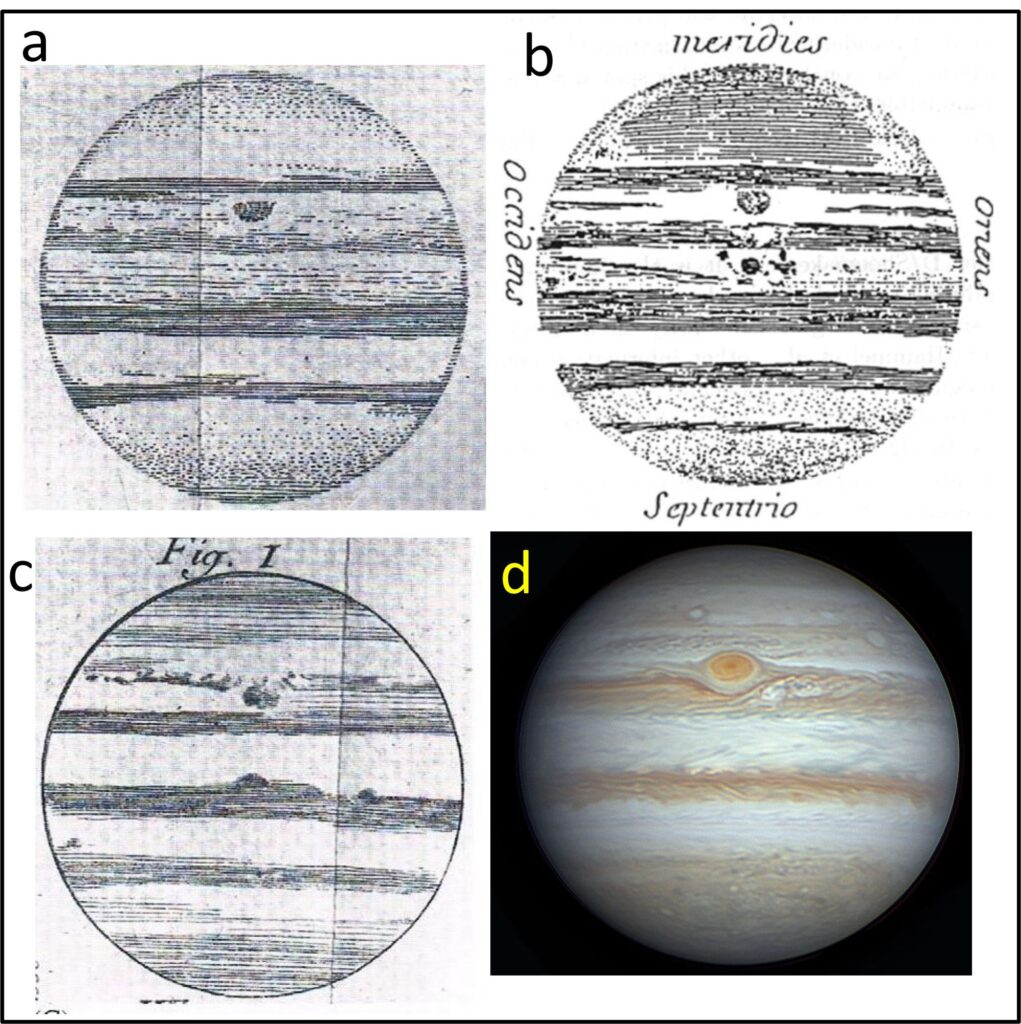The iconic feature likely formed at least 190 years ago, making it the longest-lived vortex known in the solar system
17 June 2024

Jupiter’s Great Red Spot, as seen from a Juno flyby in 2018. The Red Spot we see today is likely not the same one famously observed by Cassini in the 1600s, according to a new Geophysical Research Letters paper. Credit: Enhanced Image by Gerald Eichstadt and Sean Doran (CC BY-NC-SA) based on images provided Courtesy of NASA/JPL-Caltech/SwRI/MSSS
AGU press contact:
Rebecca Dzombak, [email protected] (UTC-5 hours)
Contact information for the researchers:
Agustín Sánchez-Lavega, University of the Basque Country, [email protected] (UTC+2 hours)
WASHINGTON — Jupiter’s iconic Great Red Spot has persisted for at least 190 years and is likely a different spot from the one observed by the astronomer Giovanni Domenico Cassini in 1665, a new study reports. The Great Red Spot we see today likely formed because of an instability in the planet’s intense atmospheric winds, producing a long, persistent atmospheric cell, the study also finds.
The Great Red Spot is the largest known planetary vortex within the solar system, but its age has long been debated, and the mechanism that led to its formation has remained obscure. The new study used historical observations from the 17th century onward and numerical models to explain the longevity and nature of this spectacular phenomenon.
“From the measurements of sizes and movements, we deduced that it is highly unlikely that the current Great Red Spot was the ‘Permanent Spot’ observed by Cassini,” said Agustín Sánchez-Lavega, a planetary scientist at the University of the Basque Country in Bilbao, Spain, who led this research. “The ‘Permanent Spot’ probably disappeared sometime between the mid-18th and 19th centuries, in which case we can now say that the longevity of the Red Spot exceeds 190 years.”
The study was published in Geophysical Research Letters, which is an open-access AGU journal that publishes high-impact, short-format reports with immediate implications spanning all Earth and space sciences.
A spotty history
Jupiter’s Great Red Spot is a massive atmospheric vortex, with a diameter approximately that of Earth’s. At its outer periphery, winds whip by at 450 kilometers per hour (280 miles per hour). Its red hue, which is due to atmospheric chemical reactions, stands in stark contrast with the gas giant’s other pale clouds.
The spot has intrigued scientists for centuries, in part because its large size makes it visible using even small telescopes. In 1665, Cassini discovered a dark oval at the same latitude as today’s Great Red Spot and named it the “Permanent Spot,” as he and other astronomers observed it until 1713, when they lost track of it. It was not until 1831 and later years that scientists once more observed a clear, oval structure at the same latitude as the Great Red Spot. Given the intermittent historical observations of Jupiter’s spots, scientists have long debated whether today’s Great Red Spot is the same one 17th-century scientists saw.

(a) In this 1711 painting by Donato Creti, a red spot is shown prominently on Jupiter—likely influenced by communications with astronomers Cassini or Manfredi. Two late-1800s drawings (b,c, Trouvelot and Elger, respectively) show elongated spots on the planet. Researchers used these illustrations and others to track Jupiter’s red spots through time. They determined today’s Great Red Spot is a different one than that which Cassini first observed.
In the study, the authors used historical sources dating from the mid-1600s to analyze the evolution of the spot’s size, structure and location over time.
“It has been very motivating and inspiring to turn to the notes and drawings of Jupiter and its Permanent Spot made by the great astronomer Jean Dominique Cassini, and to his articles of the second half of the 17th century describing the phenomenon,” Sánchez-Lavega said. “Others before us had explored these observations, and now we have quantified the results.”
How the spot was formed
The Red Spot, which in 1879 was 39,000 kilometers (about 24,200 miles) at its longest axis, has been shrinking to about the current 14,000 kilometers (8,700 miles) and simultaneously becoming more rounded, the study reported. Since the 1970s, several space missions have studied this meteorological phenomenon; most recently, observations from instruments aboard Juno have revealed that the Great Red Spot is shallow and thin — useful information for scientists looking to explore the spot’s formation.
To explore how this immense vortex could have formed, the researchers carried out numerical simulations on supercomputers using two models of the behavior of thin vortices in Jupiter’s atmosphere. The spot could have formed as a result of a gigantic superstorm, similar to those occasionally observed on Jupiter’s twin planet Saturn; from the merging of multiple smaller vortices produced by wind shear from the intense wind currents that flow parallel to each other, but alternating in direction with latitude; or from an instability in the winds that could produce an elongated atmospheric cell, similar in shape to the Spot.
The results indicate that, although an anticyclone forms in the first two cases, it differs in terms of shape and dynamic properties from those of the present Great Red Spot. The cell-producing wind instability, on the other hand, could have produced a “proto-Great Red Spot” that then shrank over time, giving rise to the compact and rapidly rotating Great Red Spot observed in the late 19th century.
The formation mechanism is supported by observations of large, elongated cells in the genesis of other major vortices on Jupiter.
Future research will aim to reproduce the Great Red Spot’s shrinking over time to elucidate the physical mechanisms underlying the Spot’s relative stability. Researchers also aim to predict whether the Great Red Spot will disintegrate and disappear when it reaches a size limit, as might have occurred to Cassini’s Permanent Spot, or whether it will stabilize at a size limit at which it may last for many more years.

Cassini’s drawings of the Permanent Spot on Jupiter in the 1600s (a-c). For comparison, (d) shows the current Great Red Spot, taken by Eric Sussenbach.
#
Notes for journalists:
This study was published in Geophysical Research Letters, an open-access AGU journal. View and download a pdf of the study here.
This is released jointly with the University of the Basque Country and modified from their press release, which is online here. Interview requests should be directed to the researchers. Media and captions to accompany this story are available here.
Paper title:
“The origin of Jupiter’s Great Red Spot”
Authors:
- Agustín Sánchez-Lavega (corresponding author), Jon Legarreta, Escuela de Ingenieria de Bilbao, Universidad del Pais Vasco (UPV/EHU), Bilbao, Spain
- Enrique García-Melendo, Manel Soria, Kevin Ahrens-Velásquez, Escola Superior d’Enginyeries Industrial, Aerospacial I Audiovisual de Terrassa, Universitat Politecnica de Cataluyna, Terrassa (Barecelona), Spain
- Arnau Miró, Barcelona Supercomputing Center, Barcelona, Spain
AGU (www.agu.org) is a global community supporting more than half a million advocates and professionals in Earth and space sciences. Through broad and inclusive partnerships, AGU aims to advance discovery and solution science that accelerate knowledge and create solutions that are ethical, unbiased and respectful of communities and their values. Our programs include serving as a scholarly publisher, convening virtual and in-person events and providing career support. We live our values in everything we do, such as our net zero energy renovated building in Washington, D.C. and our Ethics and Equity Center, which fosters a diverse and inclusive geoscience community to ensure responsible conduct.